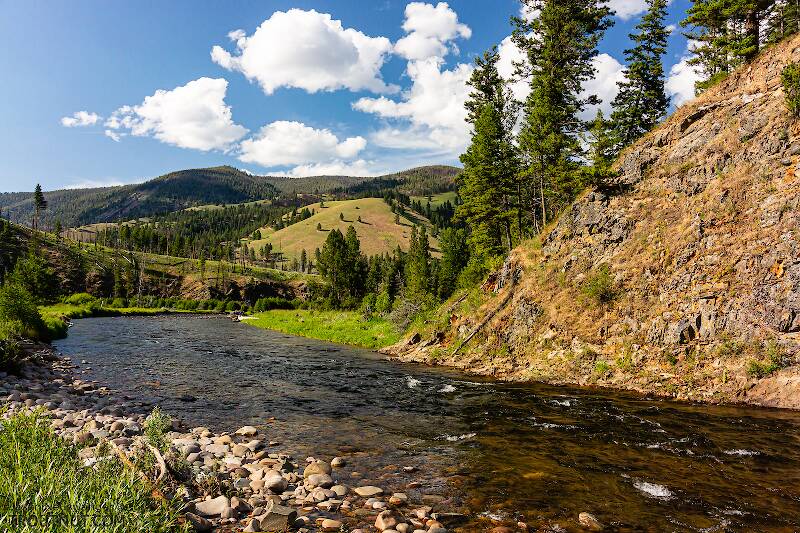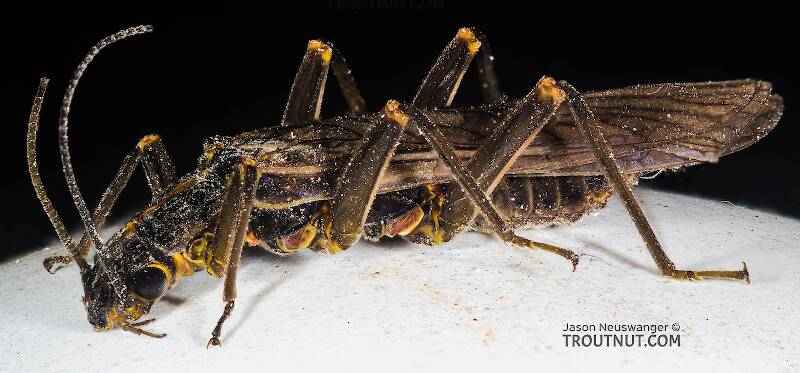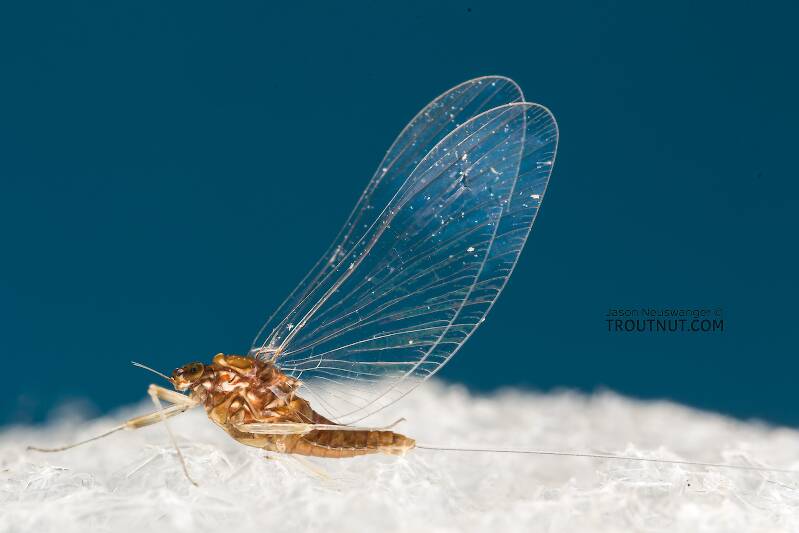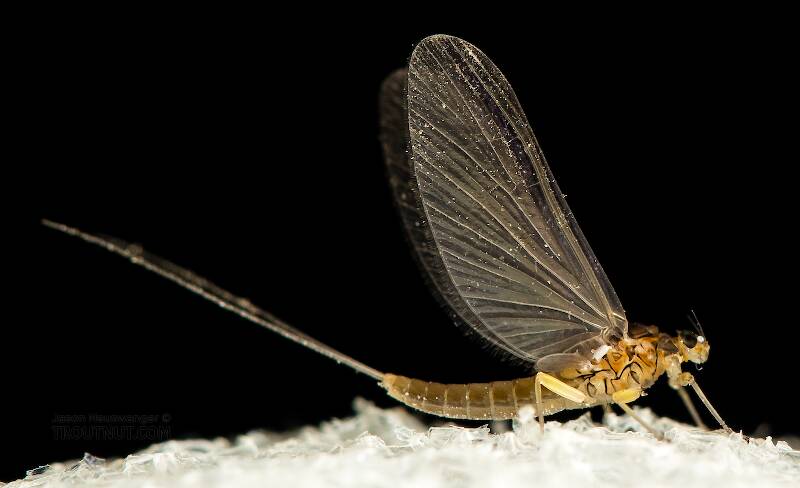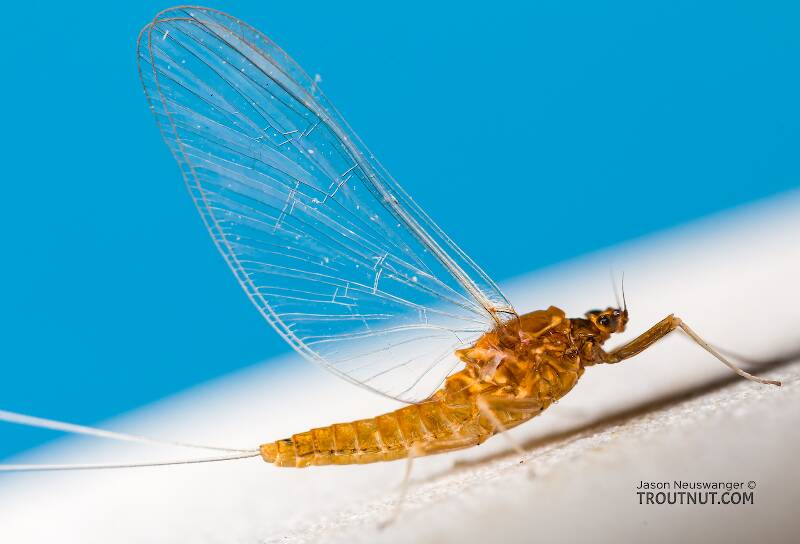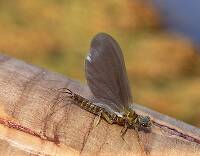
Salmonflies
Pteronarcys californica
The giant Salmonflies of the Western mountains are legendary for their proclivity to elicit consistent dry-fly action and ferocious strikes.
Featured on the forum

Troutnut is a project started in 2003 by salmonid ecologist Jason "Troutnut" Neuswanger to help anglers and
fly tyers unabashedly embrace the entomological side of the sport. Learn more about Troutnut or
support the project for an enhanced experience here.
This topic is about the Mayfly Family Baetidae
"These little critters supplant the importance of many other well-known mayfly hatches."
-Fred Arbona in Mayflies, the Angler, and the Trout
Arbona did not overestimate these critters. Their great numbers and multiple broods each season make up for their size, which is rarely larger than size 16 and often smaller than size 20.
Hardly mentioned in angling literature prior to the middle of the last century, baetids have become increasingly important to anglers, rivaling any other family of mayflies in this regard. This is largely due to the extension of fishing seasons that now include the early and late periods when this family’s species usually dominate hatching activity. Another important reason is the tremendous improvement in tackle allowing more practical imitation of these little mayflies. The dramatic ecological changes in many of our watersheds and the subsequent impact this has had on the makeup of taxa populations is also a factor.
Common baetid hatches with a national distribution are the species Acentrella turbida, Baetis brunneicolor, and Baetis tricaudatus. In the West, Baetis bicaudatus, Diphetor hageni and Plauditus punctiventris can also be common. In the East and the Midwest, look for Baetis intercalaris and Plauditus dubius. The species Iswaeon anoka is important in both the West and Midwest. Some of the Procloeon and Anafroptilum (previously Centroptilum) species are coming to the increasing notice of anglers across the country.
Stillwater anglers are likely to run across Callibaetis ferrugineus ferrugineus in the East and Midwest. Western anglers will find Callibaetis californicus and Callibaetis ferrugineus hageni to be very important.
Streamside identification of these mayflies to the level of genus, let alone species, has always been difficult. It's a very rare angler who can correctly proclaim a mayfly to be "Baetis" at a glance and be right on purpose, rather than making a lucky (albeit likely) guess at that genus versus the many others in the family. This is now even more so as new taxonomic evidence has shown hind wing conformation (or lack of hind wings) and other features are less dependable as ways to tell the genera apart. Many of the lesser-known species probably produce excellent local hatches but have not caught enough attention to be properly recognized by anglers. The lesson is that we should not assume anything about the identity of many Baetidae hatches we come across; they may not even be in the Baetis genus, let alone familiar species.
Example specimens
Softhackle on Nov 2, 2011November 2nd, 2011, 9:37 am EDT
Spence is correct. Mole is a favorite of fly tiers, especially those that tie wingless wets. It use to come only in the dark gray, but today, it comes in dyed colors. It's very fine and great for dubbing small flies, as Spence noted, like Tricos.
http://greatfeathers.com/mole-skin-by-veniard.aspx
Mark
http://greatfeathers.com/mole-skin-by-veniard.aspx
Mark
"I have the highest respect for the skilled wet-fly fisherman, as he has mastered an art of very great difficulty." Edward R. Hewitt
Flymphs, Soft-hackles and Spiders: http://www.troutnut.com/libstudio/FS&S/index.html
Flymphs, Soft-hackles and Spiders: http://www.troutnut.com/libstudio/FS&S/index.html
Oldredbarn on Nov 2, 2011November 2nd, 2011, 10:07 am EDT
Oh no! You had to show that link to me didn't you Mark! For the tyer who has everything...Except mole in seven different colors...:)
You sure you're not a rep disguised as a kindly art professor?! These boys should be sending you some clip! I put your buddy Jim's six children through college after you sent me his link and that was just from Whiting hen sets...;)
Spence
I joke...I'm not sure if Jim has any children...
Veniard...There's an old familiar name, eh!? My fly tying buddy still has some of their old dyes lying around...Back in the day he used to do a fair amount of dying. Does anyone do that anymore? We would buy a complete skin, say of a partridge, he would dye it and we would split it up after. Sometimes we would get something from a friend that hunted...I can't remember the last time that has happened...Whole pheasant, snowshoe rabbit, wood duck...I actually tried to pluck a pheasant a friend had given me...I didn't want to bother with the whole preserving thing and thought I was taking a short-cut..Yeah right! What a mess...I still have feathers from it in separate jars...I wanted to keep it separated for awhile from my other stuff for fear of unwanted critters...Anyone have any good patterns calling for phaesant feathers other than a PT Nymph or Gartside's Sparrow? :) Those feathers go back to the early 90's...I hate to say this boys out-loud, but I have enough tying materials to last me several lifetimes unless I become a pro!
You sure you're not a rep disguised as a kindly art professor?! These boys should be sending you some clip! I put your buddy Jim's six children through college after you sent me his link and that was just from Whiting hen sets...;)
Spence
I joke...I'm not sure if Jim has any children...
Veniard...There's an old familiar name, eh!? My fly tying buddy still has some of their old dyes lying around...Back in the day he used to do a fair amount of dying. Does anyone do that anymore? We would buy a complete skin, say of a partridge, he would dye it and we would split it up after. Sometimes we would get something from a friend that hunted...I can't remember the last time that has happened...Whole pheasant, snowshoe rabbit, wood duck...I actually tried to pluck a pheasant a friend had given me...I didn't want to bother with the whole preserving thing and thought I was taking a short-cut..Yeah right! What a mess...I still have feathers from it in separate jars...I wanted to keep it separated for awhile from my other stuff for fear of unwanted critters...Anyone have any good patterns calling for phaesant feathers other than a PT Nymph or Gartside's Sparrow? :) Those feathers go back to the early 90's...I hate to say this boys out-loud, but I have enough tying materials to last me several lifetimes unless I become a pro!
"Even when my best efforts fail it's a satisfying challenge, and that, after all, is the essence of fly fishing." -Chauncy Lively
"Envy not the man who lives beside the river, but the man the river flows through." Joseph T Heywood
"Envy not the man who lives beside the river, but the man the river flows through." Joseph T Heywood
Softhackle on Nov 2, 2011November 2nd, 2011, 10:52 am EDT
Spence,
No kick-back coming this way. I just thought if someone was interested in seeing the colors available, I'd show a link. Get out your wallet, although each skin is really not that expensive.
Mark
No kick-back coming this way. I just thought if someone was interested in seeing the colors available, I'd show a link. Get out your wallet, although each skin is really not that expensive.
Mark
"I have the highest respect for the skilled wet-fly fisherman, as he has mastered an art of very great difficulty." Edward R. Hewitt
Flymphs, Soft-hackles and Spiders: http://www.troutnut.com/libstudio/FS&S/index.html
Flymphs, Soft-hackles and Spiders: http://www.troutnut.com/libstudio/FS&S/index.html
Oldredbarn on Nov 2, 2011November 2nd, 2011, 11:37 am EDT
You know Mark it's kind of strange, you know how some people like to knit to wile-away-the-time, I love to dub...With natural fibers especially...Muskrat, Beaver, Mole, and rabbit. When I mix up my own colors from the skin for dry flies I spend a great deal of time removing guard hairs and fluffing it up in to a soft wisp and then the actual applying is a breeze...My mentor would pull out his cheater glasses and peer in to my finished product like I was taking a final exam or something. Looking for that one fiber of guard hair that I may have missed...:)
I have these containers marked with all these un-used mixtures for my bug bodies. The funny thing is that I actually rank "color" somewhere down the line after all the other factors that seem important to a finished fly's success. Go figure?!
You should see me when I'm cleaning out the under fur when I'm working with deer...I could tie like a madman, and have a zillion flies tied up, if it wasn't for being so damn neurotic...Lets just say, fastidious. :) If someone were watching me they would go nuts...I have since incorporated a hair comb, but I used to do it with just my bodkin needle...I would run it through the hair and blow on it and stack it and make sure it was all clean...Ouch.
My commercial buddies would cringe! But I would have to admit that it was all a bit calming...The Wings game on or some background music...
Spence
Another odd thing I've learned to do is leave the finished fly until the next day...I have a little hard sided box and I deposit the finished flies in to it and try not to look at it until the next day...I get in to a hyper-critical mode when I'm tying and they look just fine if I let them sit a bit.
I have these containers marked with all these un-used mixtures for my bug bodies. The funny thing is that I actually rank "color" somewhere down the line after all the other factors that seem important to a finished fly's success. Go figure?!
You should see me when I'm cleaning out the under fur when I'm working with deer...I could tie like a madman, and have a zillion flies tied up, if it wasn't for being so damn neurotic...Lets just say, fastidious. :) If someone were watching me they would go nuts...I have since incorporated a hair comb, but I used to do it with just my bodkin needle...I would run it through the hair and blow on it and stack it and make sure it was all clean...Ouch.
My commercial buddies would cringe! But I would have to admit that it was all a bit calming...The Wings game on or some background music...
Spence
Another odd thing I've learned to do is leave the finished fly until the next day...I have a little hard sided box and I deposit the finished flies in to it and try not to look at it until the next day...I get in to a hyper-critical mode when I'm tying and they look just fine if I let them sit a bit.
"Even when my best efforts fail it's a satisfying challenge, and that, after all, is the essence of fly fishing." -Chauncy Lively
"Envy not the man who lives beside the river, but the man the river flows through." Joseph T Heywood
"Envy not the man who lives beside the river, but the man the river flows through." Joseph T Heywood
Minnesota on Nov 2, 2011November 2nd, 2011, 10:01 pm EDT
Novi, I started tying flies when I was 12. I hand plucked a road-kill pheasant and put them in GLASS TANG jars. I still have them. Never use them much, LOL. They sure are pretty though. That was in the late 80's. Also, a disposable razor works good for getting hair off mole skin.
Jason Moe
Sayfu
Posts: 560
Posts: 560
Sayfu on Nov 20, 2011November 20th, 2011, 11:11 am EST
Interesting aspect that I think about regarding these flies, is I could have caught lots of steelhead on anyone of them. Not quite as small as they are tied, but 14's for sure. These were a lot like I used only my bodies were not as slime because I gob on the dubbing, but virtually the same.
Entoman on Jan 24, 2012January 24th, 2012, 8:17 pm EST
Hi Jere -
It is highly unlikely those are Baetis. They're actually the closely related species Iswaeon anoka (formerly known as Pseudocloeon Edmundsi). They often go by the names Tiny Western Olive or Little Chartreuse Quill. Check out its hatch page for interesting info. Please leave some comments there as your experiences with this hatch would really add to the page.
Sorry for not commenting sooner. I don't know how I missed noticing this in your post the first time, other than my mind must have been really absorbed with discussing soft hackles.;)
I had locked in on our Fall Baetis that were size # 20-22's I would guess, and having the fluorescent, green bodies, but not so this Fall.
It is highly unlikely those are Baetis. They're actually the closely related species Iswaeon anoka (formerly known as Pseudocloeon Edmundsi). They often go by the names Tiny Western Olive or Little Chartreuse Quill. Check out its hatch page for interesting info. Please leave some comments there as your experiences with this hatch would really add to the page.
Sorry for not commenting sooner. I don't know how I missed noticing this in your post the first time, other than my mind must have been really absorbed with discussing soft hackles.;)
"It's not that I find fishing so important, it's just that I find all other endeavors of Man equally unimportant... And not nearly as much fun!" Robert Traver, Anatomy of a Fisherman
Softhackle on Feb 16, 2012February 16th, 2012, 3:40 pm EST
You know, Spence, I forgot to address the reference to Embroidery threads. So we'll resurrect this thread, and that's good cause soon, Baetis will be hatching.
The inexpensive cotton embroidery threads sold in large department stores and sewing and craft supply stores will work okay for tying abdomens in soft-hackles, and you can match any color of natural flies because it comes in tons of colors- tints and tones.
Unlike silk, it only darkens slightly went wet, but does not get transparent like silk. You can buy silk embroidery thread if you search for it.
Get ready, spring will be upon us, soon.
Also, here's Hans doing a "simple" split thread technique on a soft-hackle.
http://www.youtube.com/watch?v=Tm0EezHtnjY&feature=youtu.be
Mark
The inexpensive cotton embroidery threads sold in large department stores and sewing and craft supply stores will work okay for tying abdomens in soft-hackles, and you can match any color of natural flies because it comes in tons of colors- tints and tones.
Unlike silk, it only darkens slightly went wet, but does not get transparent like silk. You can buy silk embroidery thread if you search for it.
Get ready, spring will be upon us, soon.
Also, here's Hans doing a "simple" split thread technique on a soft-hackle.
http://www.youtube.com/watch?v=Tm0EezHtnjY&feature=youtu.be
Mark
"I have the highest respect for the skilled wet-fly fisherman, as he has mastered an art of very great difficulty." Edward R. Hewitt
Flymphs, Soft-hackles and Spiders: http://www.troutnut.com/libstudio/FS&S/index.html
Flymphs, Soft-hackles and Spiders: http://www.troutnut.com/libstudio/FS&S/index.html
Quick Reply
Related Discussions
Topic
Replies
Last Reply
4
Oct 26, 2011
by Keystoner
by Keystoner

